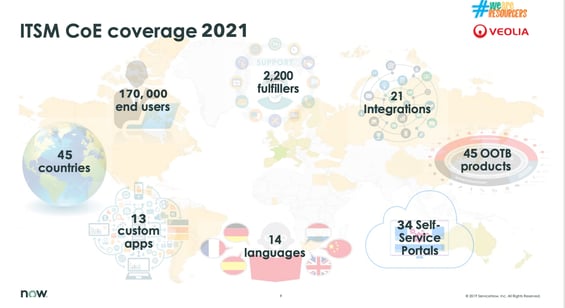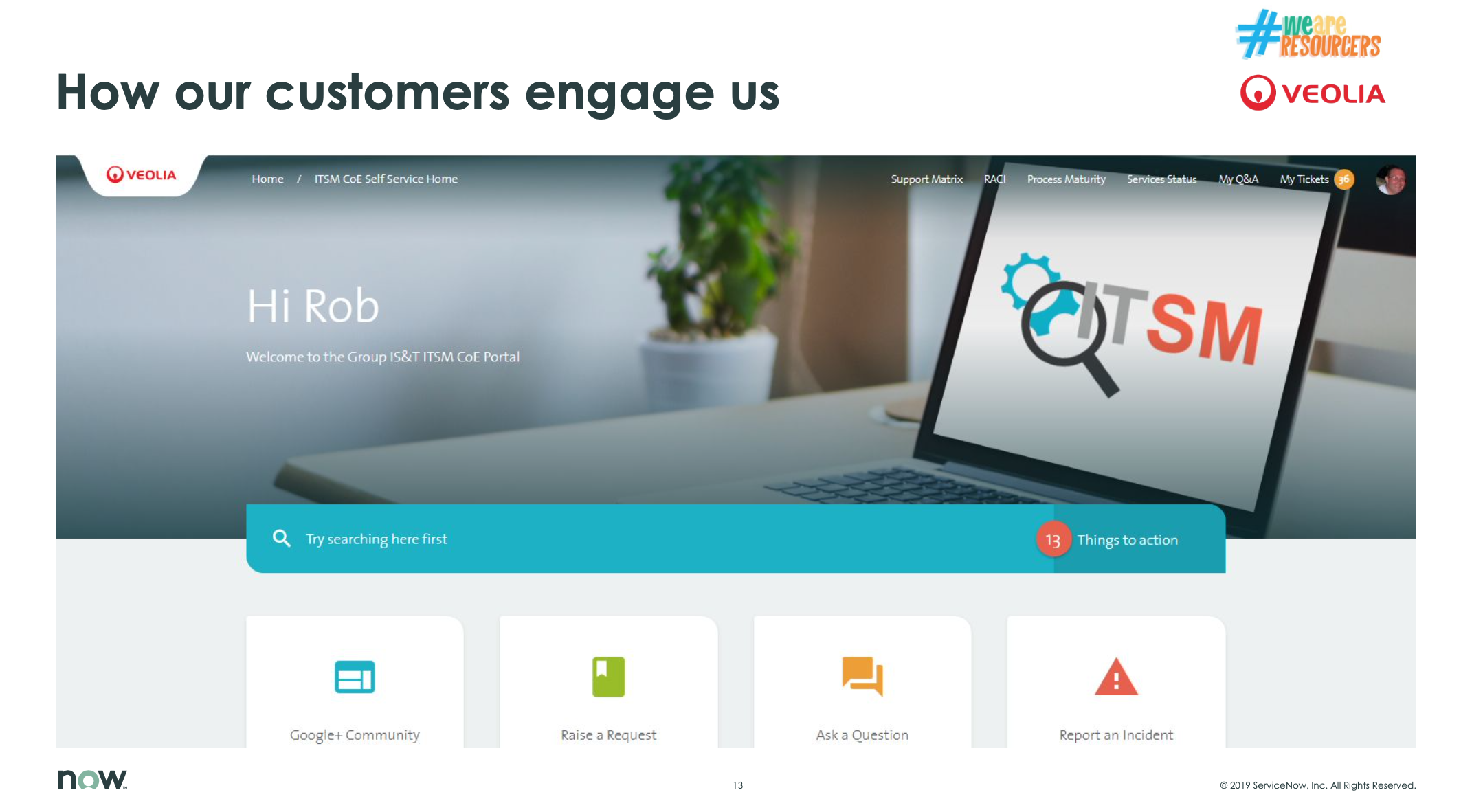Leader’s View: Veolia on Transforming the Digital Service Management

We asked Senior Executives to share their perspective on the evolution of end-user support and the Digital Transformation of the Service Desk. Today’s insights are from Rob Gwatkin, Global Senior Service Delivery Manager, in the Digital Service Management team at Veolia.
Veolia group is the global leader in optimized resource management, with nearly 178,780 employees worldwide, and 26.01 billion revenue in 2020.
Rob’s three main responsibilities : product owner of the ServiceNow production platform globally (45 countries), Customer Service Manager, and global process owner.
What is the context of Veolia’s DSM CoE transformation
Veolia is a global group, headquartered in Paris and with specific business units in 85 countries. Each BU are their own company, with back office and operations as an entity. This means hundreds of projects evolving at different speeds, with different teams, different needs and different priorities.
In 2014, Veolia launched its digital transformation strategy with a « digital first » and « cloud first » focus for the entire organization. BUs and IT departments in different countries had different digital maturity levels and different processes without consistency.
So the idea was to use a single platform to move people away from individual processes, centralise the functions that made sense to centralise, and offer them to any BU. None of the business unit had an IT department with a unified ITSM Tool.
So we chose ServiceNow as the foundation platform for our new DSM CoE (then ITSM Centre of Excellence), with 3 objectives : to provide a Service Management model that meet the core values of service Excellence, to provide and develop a global service management toolset, and to influence and support local Service Management capability improvement.
The team provides a full DevOps lifecycle model encompassing platform support as well as major and minor enhancement build.
After an original launch in 8 countries, starting with North America, Canada, UK, and Ireland, now 45 countries are using the platform.

GHow does Veolia‘s digital transformation apply to the DSM CoE ?
Our digital transformation strategy aims at achieving economy of scale, simplicity, commonality, and offering tool set and workflow capabilities. The same logic applies for the IT service desk as it does for having a single HR ERP system, single communication and collaboration tools, and single cloud-based contracts.
A cloud-based solution is available anywhere, on any device, and secure. It also removes the need for internal infrastructure, moves us away from costly contracts, and from the requirement of having multiple technology skill sets in house to assure self-reliance.
How do the users react to the digital transformation of the service desk ?
Depending on the business units, some people have an appetite for change and react exceptionally well. Others react cautiously for a variety of reasons. But the majority of responses have always been, and still are, positive. Remember that “You can please some of the people all of the time, you can please all of the people some of the time, but you can’t please all of the people all of the time”.
What KPI do you monitor for global Service Delivery ?
We measure success by three key metrics. Volume, « How many things we build and deploy», with small, medium, and large projects. Agility, « How quickly we build and deploy them ».
We also identify what are the blockers in that cycle time and reduce those block times. And Quality, « How often we break things » to make sure we don’t get it wrong in the future , and when things do go wrong « How well do we remediate ».
We also measure our customer satisfaction in two ways.
Firstly, as a pure customer service metric (CSAT), with questions at different parts of the customer journey and instant touchpoints, for instance at the end of the request fulfilment or incident process.
Last year, we also deployed Net Promoter Score (NPS) mechanisms. Even if it is not a classic free market NPS, it is a useful metric to measure the two core service components of the DSM: the tool (with the question « would you recommend the platform ») and the team (« would you recommend the DSM team »). We are very pleased that for 2020, our CSAT was 95% and our NPS was 90%, but there’s still room for improvement.
How did you see the DSM CoE evolving over the last 5 years ?
Some of the best examples of our evolution are the growth outside of our traditional IT focus areas. The platform is now used for Supply Chain, HR, Training and Development, and Facilities, with a Fleet services application in build.
The platform has also been adopted for Risk Reporting and management, legal case management, robotics case management. All those non-IT cases, show the flexibility of a service management platform.
The evolution is partly driven by a very active Digital service management community, organized in a Community of Practice (CoP). We collaborate in Google Workspace by posting information 2 or 3 times a week about teams project or functionalities. We also have a monthly community call, regular webinars, and an intranet for self-service access to information.
I also see the power of the ecosystem, with customer driven evolutions. There is nothing that they can’t ask, every demand is treated with the same respect and diligence. And of course we always spend time with the person making sure their requirements are clearly understood. It is never « solution first » but always « outcomes first ».
How do you see AI contributing to the evolution of the Service?
Artificial Intelligence is still very new within the Veolia SM arena, we have only scratched the surface. We manage more than 300 000 incidents or requests a year across the entire group, and across 45 countries.
With the introduction of a chatbot for some local Service Desks, and for HR in the UK earlier this year, we try and shift the focus away from having to manually respond to every customer contact.
We drive the conversation to the left, enabling users to find answers and solutions for themselves, in a way that is good for them. This is one of the main trends shaping the Service landscape, «self-service first » and « knowledge first ».
And when you start to introduce chatbot, you also get more data, and people get better at registering data in the correct way. But we need consistency of the data to get quality of AI.
Otherwise you can get worse outcome. So the journey we are going through now is about classifying information. We need to think about the organizational structure, and about the teams that will receive the requests. We need to make sure that the data capture mechanisms are structured in a way that makes sense for the users and is reusable for an AI.
Also remember that Artificial Intelligence is only as good as its training. In fact Luc Julia, who invented Siri, wrote that « There is no such thing as AI », because we need to teach it how to learn and what to learn. And you need a volume of learning material to draw from and comb that material.
What lessons did you draw from the introduction of AI in the Service Desk ?
The biggest lesson for us was to heavily invest time and effort in training prior to launch, «to minimise the potential for poor response after product launch ». It is something that a lot of people miss. Poor responses can have a very long lasting negative psychological impact on how they perceive chatbots or any form of AI.
For us, a poor response is something totally nonsensical, or a dead end. Inversely, not having an answer and handing over gracefully to a live agent is an acceptable response. Invest heavily in AI training before going live.
That is why the tool you select must be easy to use to be trained, and as close to the point of contact as possible. And this training of the chatbot is better done by the people who best understand the context of the conversations rather than those who don’t.
These are usually the live agents or service desk analysts and team leaders, who handle the conversation or ticket if the bot cannot provide a useful outcome, rather than a developer.
We also learn from our mistakes. We tried to beta-test with a small subset of users, but we just could not generate the volume of data to validate the training. But we did have several years of live chat data to draw from on how people ask questions, specific words, acronyms, colloquialism, and local language variation. This was a huge benefit for us.
We partnered with Konverso as they provided all of the capabilities we were looking for. In addition we also don’t have to worry about translations because the bot is configured locally in the language of the consuming BU.
What lessons did you draw from the introduction of AI in the Service Desk ?
I can sum up this journey by explaining that we went from chaos to excellence. We made lots of mistakes but it is important to not be afraid to make mistakes, be honest enough to admit a mistake and correct it quickly.
Over time we have learned from ours and others mistakes and successes. We have adapted and evolved our product, our processes, and our way of thinking in order to deliver continuous build, continuous test, and continuous release. Utilizing a combination of methodologies (SAFe, ITIL, LEAN etc), experience, and product functionalities.






